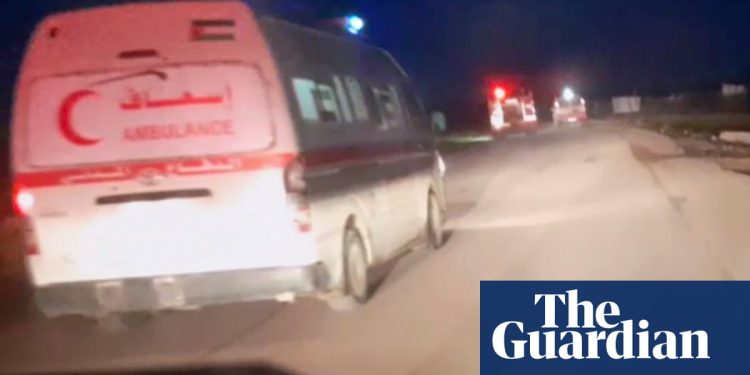The Israeli army went backwards for the murder of 15 Palestinian doctors in Gaza last month after images contradicted its assertions that their vehicles did not have emergency signals when the Israeli troops opened fire.
The army initially declared that it had opened fire because the vehicles advanced “with suspicion” on the neighboring troops without headlights or emergency signals. An Israeli military official, speaking on condition of anonymity in accordance with the regulations in the end on Saturday, said the account was “wrong”.
The video of almost seven minutes, which, according to Palestine Red Crescent Society (PRCS), was recovered on Saturday on the phone of Rifat Radwan, one of the men killed, seems to have been filmed from the inside of a moving vehicle. It shows a red fire and clearly marked ambulances leading the night, using flashing headlights and emergency lights.
The vehicle stops next to another which has left the road. Two men go out to examine the arrested vehicle, then the shots burst before the screen became black.
Fifteen Palestinian paramedical paramedics and rescuers, including at least one UN employee, were killed during the incident in Rafah on March 23, in which the UN declared that the Israeli forces shot men “one by one”, then buried them in a serious mass.
Israeli defense forces (FDI) said the incident was still inquiry. He added: “All the affirmations, including the documentation disseminated on the incident, will be examined in depth and deeply to understand the sequence of events and the management of the situation.”
The manager said that the initial report received from the field did not describe the lights, but that the investigators were considering “operational information” and tried to understand if this was due to an error of the person who made the initial report.
“What we currently understand is that the person who gives the initial account is wrong. We are trying to understand why,” added the official.
According to the United Nations Office for the Coordination of Humanitarian Affairs (OCHA), the RPC and the Civil Defense workers were on a mission to save colleagues who had been slaughtered earlier in the day, when their clearly marked vehicles were the subject of heavy Israeli fire in the Rafah Al-Sultan region. An official of the Red Crescent in Gaza said that there were evidence of at least one detained and killed person, because the body of one of the dead had been found with his linked hands.
The shots took place one day after the Israeli offensive renewed in the region near the Egyptian border after the break of a two-month ceasefire between Israel and Hamas.
On Sunday, Israeli strikes in Gaza killed at least 44 people, the rescuers said. “The number of deaths following Israeli air strikes since dawn today is at least 44 years old, including 21 in Khan Younis,” spokesman for the civil defense agency Mahmud Bassal, AFP told AFP.
Such a strike killed six people on Al-Nakheel Street in the Al-Tuffah district of Gaza City, where a group had gathered near a bakery, said Bassal. Among the dead, there were three children, he confirmed.
Hamas said on Sunday evening that he had pulled a roquette dam in cities in the south of Israel on Sunday in response to the Israeli “massacres” of civilians in Gaza.
The FDIs said that around 10 projectiles had been dismissed, but most of them were successfully intercepted. Israel’s 12 chain has reported a direct blow in the southern city of Ashkelon.
The Israeli emergency services said they were dealing with a person for bursts of buses and that the teams were on the way to locations of fallen rockets. Broken car windows and debris were scattered in a city street, have shown videos broadcast by Israeli emergency services.
Another worker of the Red Crescent on mission last month, Assad al-Nassasra, is still missing and the organization has asked the Israeli army of information on its fate.
A survivor of the incident, the paramedical of the Palestinian Red Crescent Munther Abed, said that he had seen Nassasra led his eyes bandaged by Israeli troops.
The 27 -year -old volunteer was at the rear of the first ambulance to arrive at the scene of an air strike in the Hashashin region in Rafah before dawn on March 23 when the vehicle passed under intense Israeli fire.
His two colleagues from the Red Crescent Sitting at the front were killed but he survived by throwing himself on the ground of the vehicle. “The door was opened, and they were there – Israeli special forces in military uniforms, armed with rifles, green lasers and night vision glasses,” Abed told Guardian. “They dragged me out of the ambulance, keeping me opposite to avoid seeing what had happened to my colleagues.”
ADEB was detained for several hours before being released.
The UN and the Palestinian red crescent demanded an independent investigation into the murder of paramedical paramedics.
The Israeli media informed by the army reported that the troops had identified at least six of the 15 dead as members of militant groups and killed a figure of Hamas named Mohammed Amin Shobaki.
None of the 15 killed has this name and no other body is known to have been found on the site. The manager refused to provide evidence or details on how the identifications have been made, saying that he did not want to share classified information.
“According to our information, there were terrorists there, but this investigation is not over,” he told journalists.
ABED – A volunteer for 10 years – was categorical, there were no militants traveling with the ambulances.
Jonathan Whittall, the OCHA interim chief in the occupied Palestinian territory, rejected allegations that deceased people were Hamas activists, saying that the staff had worked with the same doctors before in the evacuation of patients from hospitals and other tasks.
“These are paramedical crews that I have personally encountered before,” he said. “They were buried in their uniforms with their gloves. They were ready to save lives. ”
The Israeli military leader said the troops had informed the incident on the same day and initially covered the camouflage nets until they could be recovered, buried them later when the UN did not immediately collect the bodies.
The UN confirmed last week that it had been informed of the site of the bodies, but that access to the region was refused by Israel for several days. He said the bodies had been buried alongside their crushed vehicles – clearly marked ambulances, a fire truck and a United Nations car.


